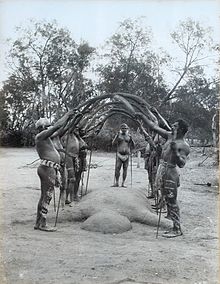Bora (initiation)
The bora is an initiation ritual of the Kamilaroi , an Aboriginal tribe in the south of Australia in the area of New South Wales .
The ritual with which ten-year-old boys are released into manhood differs in the various tribal cultures, often including scarification , circumcision , pulling a tooth or cutting off finger joints.
This ceremony is carried out at so-called Bora places. The best known is Terry Hie Hie , which is 60 kilometers from Moree . There are other ring-shaped places in Australia where the bora is performed. The Bora rituals are known in 1880 at Garah , 1883 at Terry Hie Hie, 1890 in Queensland , 1894 in Gundabluey-South-West near Mungindi and 1905 in Wee Waa ( Wiawa ).
The bora is performed in the presence only by men, and it is prepared in the long term by the groups and families of the Aborigines.
terminology
The word Bora originally comes from the Gamilaraay language spoken by the Kamilaroi who lived in the region north of the Hunter Valley in New South Wales in southern Queensland . It was then widely adopted to describe similar ritual places and the associated ceremonies that were performed in eastern Australia. Many other terms exist in Australia to denote similar initiation rites on a ceremonial ground such as Burbung ( Wiradjuri ) and Kuringal ( Yuin ).
literature
- Robert Hamilton Matthews: The Bora or Inititions Cereminies of the Kamilaroi. In: The Journal of the Anthropological Institute of Great Britain and Ireland. Volume 24, 1895, pp. 411-415.
Individual evidence
- ^ Robert S. Fuller and others: Astronomical Orientations of Bora Ceremonial Grounds in Southeast Australia. In: Australian Archeology. No. 77, 2013, pp. 30–37, here p. 31 ( PDF file; 1.5 MPB, 13 pages ).
- ^ Robert S. Fuller and others: Astronomical Orientations of Bora Ceremonial Grounds in Southeast Australia. In: Australian Archeology. No. 77, 2013, pp. 30–37, here p. 30.
- ^ Mitchell Rolls, Murray Johnson: Historical Dictionary of Australian Aborigines. Scarecrow Press 2010, ISBN 978-0-810-87475-6 , p. 40 ( side view in Google book search).
- ^ Ronald Murray Berndt: Australian Aboriginal Religion. Parts 1-4, Brill, Leiden 1974, ISBN 978-9-004-03861-5 , p. 28 ( side view in the Google book search).
